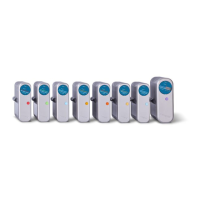ENGINEERING MANUAL OF AUTOMATIC CONTROL
INDOOR AIR QUALITY FUNDAMENTALS
160
DECREASE IN BAR WIDTH
INDICATES DECREASE
IN EFFECT
BACTERIA
VIRUSES
FUNGI
MITES
RESPIRATORY
INFECTIONS #
ALLERGIC RHINITIS
AND ASTHMA
CHEMICAL
REACTIONS
OZONE
PRODUCTION
# INSUFFICIENT DATA
ABOVE 50% RH
RELATIVE HUMIDITY, PERCENT
0 102030405060708090100
OPTIMUM RELATIVE HUMIDITY RANGES FOR HEALTH
OPTIMUM ZONE
M10481
Effects of Humidity
Controlling relative humidity between 40 and 60 percent
has a beneficial impact on health and therefore, productivity.
Figure 2 shows the effect of relative humidity on bacteria,
viruses, fungi, mites, respiratory infections, allergic rhinitis,
asthma, chemical reactions, and ozone production. The
choice of the optimum zone is a compromise. It is
informative to note the overlap of ozone production and
chemical reactions, since ozone is such an active oxidizer.
Ozone may not be generated at high humidity, but if present
it will certainly react. Also note that bacteria, viruses, fungi
mites, and chemical reactions all thrive in the high moisture
content found in the drain pans, humidifier discharges, and
on the cooling coils if they are dehumidifying. Some state
building codes prohibit humidification above 30 percent
space levels in the winter except for special occupancy uses.
Refer to ASHRAE Standard 55-1992 Thermal Environmental
Conditions for Human Occupancy for more information.
The relative humidity in the supply air duct after the humidifier
will approach 100 percent and condense unless controlled.
Condensation in the duct promotes the growth of mold and fungi
and has been the source of air quality problems in many buildings.
Proper maintenance is essential for the control of contaminants
and bioaerosols. Assuming that return air relative humidity is the
same as space relative humidity is a common mistake. They are
the same only if the two temperatures are the same. Maintaining
the relative humidity below 60 percent frequently requires
dehumidification by the cooling coil resulting in condensation of
moisture on the coils. If this moisture is not removed through
proper drainage it promotes the growth of mold and fungi and
has been the source of air quality problems in many buildings.
DESIGN PROCEDURES
GENERAL
ASHRAE Standard 62-1989 sets the IAQ standard for design
professionals by specifying the minimum ventilation rates and
IAQ that are acceptable to human occupants and is intended to
minimize the potential for adverse health effects. This standard
defines two methods that can be used to achieve these goals.
— Ventilation Rate Procedure: Provides ventilation air of
the specified quality and quantity to the space.
— Indoor Air Quality Procedure: Controls known and
specifiable contaminants within the space.
This standard also requires detailed documentation of design
assumptions and intent to permit the operating personnel to
maintain the system as designed to assure continued IAQ during
occupancy. The standard is currently in the normal review
process. Many changes are being proposed, including
incorporating code language, i.e., shall.
Fig. 2. Effect Of Changes in Relative Humidity on Various Items.

